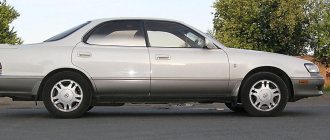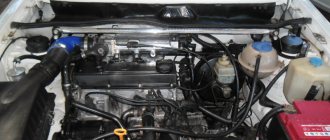The Toyota 5E-FE is a 1.5 L (1497 cc) four-cylinder, 4-stroke petrol engine from the Toyota E-family. The Toyota 5E-FE engine was produced from 1990 to 1998.
The 5E-FE engine used a cast iron block and aluminum cylinder head with double overhead camshafts (DOHC) and four valves per cylinder (16 in total). With a 74.0 mm bore and 87.0 mm stroke, the 5E-FE engine has a displacement of 1,497 cc. The compression ratio is 9.8:1.
The Toyota 5E-FE engine has an electronic fuel injection system and different ignition systems: distributorless ignition system, distributorless ignition system with coil pack and electronically controlled, and after 1995 Toyota changed the ignition system to a distributorless system (DIS), fork-mounted design. The coil-on-plug design uses two coils, each coil is mounted on top of the spark plug but also has a cable running to the other cylinder's spark plug. In 1995, Toyota switched from OBD to OBD-II and began using flat-top pistons.
The engine produces from 94 hp. (69 kW; 92 hp) at 5400 rpm up to 112 hp (82 kW; 110 hp) at 6400 rpm maximum power and from 123 N⋅m (12.5 kg⋅m) at 3200 rpm to 136 N⋅m (13.9 kg⋅m) at 4000 rpm peak torque.
The engine code breakdown is as follows:
- engine 5th - 5th generation
- E - engine family
- F - Economical narrow-angle DOHC
- E - multipoint fuel injection
| Engine characteristics 5E-FE | |
| Engine code | 5E-FE |
| View | Four-stroke Inline-4 (Straight-4) |
| Fuel type | Petrol |
| Years of production | 1990-1998 |
| Volume | 1.5 l, 1,497 cm 3 (91.35 c.u.) |
| Fuel system | Electronic fuel injection (EFI) |
| Turbine | — |
| Horsepower | From 94 hp (69 kW; 92 hp) at 5400 rpm up to 112 hp (82 kW; 110 hp) at 6400 rpm |
| Torque | 123 N m (12.5 kg m) at 3200 rpm to 136 N m (13.9 kg m) at 4000 rpm |
| Cylinder operating order | 1-3-4-2 |
| Dimensions (L × H × W) | — |
| Weight | — |
List of car models in which it was installed
The Japanese manufacturer intended the 5E FE naturally aspirated engine to equip Toyota C-class passenger cars:
- Cynos – 1st generation coupe in the EL44 body, 1991 – 1995;
- Corolla I, II – 7th generation station wagon in the E100 body, 1991 – 1998, 3rd and 4th generation hatchback in the L40, L50 body, 1990 – 1998;
- Paseo – coupe 1st and 2nd generation, 1995 – 1998;
- Caldina – station wagon in the T190 body, 1992 – 1998;
- Sera – two-door coupe in EXY10 body, 1990 – 1995;
- Corsa – sedan and hatchback 4th, 5th generation in L40, L50 bodies, 1990 – 1998;
- Raum – 1st generation hatchback in the Z10 body, 1997 – 1998;
- Tercel – sedan and hatchback 4th, 5th generation in L40, L50 bodies, 1990 – 1998;
- Sprinter – 7th generation station wagon in the E100 body, 1991 – 1998;
- Starlet – 4th and 5th generation hatchback in NP80, EP82, EP85, NP90, EP91, EP95 bodies, 1990 – 1998.
Toyota Sera
Since the engine characteristics did not fully satisfy the requirements of the listed car models, some of them were equipped with 5E-FHE versions.
The procedure for removing the cylinder head on a VAZ 2108-2109
Of course, it will be necessary to first carry out some preparatory procedures, without which it will be impossible to remove the head.
- First, you need to remove the air filter housing
- Then disconnect all fuel hoses and power wires from the carburetor or injector (depending on the type of engine)
- , although this is not a prerequisite - it will be enough to disconnect the high-voltage wires
In general, it is necessary to free the head from everything unnecessary so that during dismantling there are no unnecessary problems. Of course, if you decide to completely replace it or repair it, then you will have to perform more operations, both the carburetor and the manifolds. Well, if it’s just a matter of gasketing, then you can get by with a minimum of actions.
To unscrew the cylinder head on a VAZ 2109-2108, you need to use a powerful wrench and a hexagon, since the bolts securing it to the cylinder block are tightened with a large torque. In total you will have to unscrew 10 bolts, which are shown in the photo below:
As a lever, you can use a nozzle in the form of a regular metal pipe:
Then you can remove the bolts along with washers, as shown in the picture:
And now you can carefully lift the VAZ 2109-2108 cylinder head up, removing it from the engine block:
After which the following picture opens to us:
Advantages and disadvantages
The undoubted advantages of the 5E FE motor for users are:
- the piston does not bend when the timing belt breaks;
- The DIS-2 ignition system is more progressive compared to the contact one from a single coil through distributors, but there is an idle spark on the exhaust valve, so the spark plugs wear out faster;
- The simplest design of the CPG and timing belt allows you to carry out major repairs on your own.
Pistons 5E-FE
The disadvantages of the 5E-FE power drive are:
- attachments with low resource;
- oil leakage from under the thin cylinder head gasket after the head overheats or in the absence of grinding of the block/cylinder head seats.
The E series does not initially have hydraulic compensators, therefore, with every 30,000 km added to the speedometer, adjustment of the valve thermal clearances is necessary.
List of internal combustion engine modifications
An important feature of the 5E-FE engines was their suitability for Toyota C-series car models. However, the Toyota Sera, with its heavy liftgates, required a more powerful powertrain. The manufacturer recommended developing a modification 5E-FHE with the following characteristics:
- torque – 135 Nm;
- power – 110 l. With.;
- compression ratio - 9.8.
The fuel for it is exclusively gasoline with a high octane number of AI-95 and higher. The attachments have changed somewhat, in particular the geometry of the intake tract has been changed. This version of the engine was later installed on Cynos for the domestic market and Paseo for export to America.
An exhaust manifold
The 5E-FHE version has its own modification, which differs exclusively in the intake manifold of fixed geometry from the 4FTE turbo engine, although this engine is naturally aspirated. This manifold has short runners, which is more convenient for high revs.
Procedure for replacing the cylinder head gasket on a VAZ 2109-2108
The gasket may remain either on the surface of the head or stick to the block itself. You can try to remove it by hand without using any tools, and if that doesn’t work, you can carefully pry it off with a flat-head screwdriver without damaging the surface of the part.
Carefully inspect the surface of the cylinder head and if pronounced traces of corrosion are found on it, especially in close proximity to the coolant channels, then it is necessary to repair it: milling, grinding, etc. If everything is normal, then we remove traces of the old gasket using special means:
We wait a few minutes until the whole thing has cooled down and remove the residues that have not succumbed to the chemicals, if any remain, with a razor blade. Then we wipe everything dry and you can even degrease it so that no foreign traces remain on the surface:
The engine block also needs to be cleaned and then a new gasket installed on it. It is important that the holes in the gasket coincide with the guides, which are located at the corners of the block:











